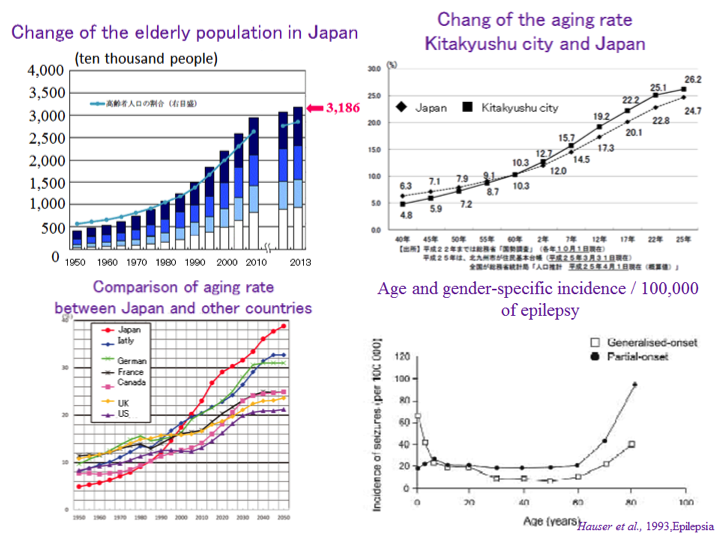Epilepsy
★To clarify the pathology of epilepsy and develop the new treatments
•About 20-30% of all patients with epilepsy are intractable. The reason why so many patients are intractable is that the treatments based on molecular pathology are not performed in epilepsy.
Genomic analyses of epilepsy are fewer than other neurological disease.
•Our goal is to identify genes that influence the development of epilepsy and genes that affect the response to treatment. We will perform genomic analyses of epilepsy patients and clarify the pathology of epilepsy using cultured cell and transgenic animal models.
★Mesial Temporal Lobe Epilepsy, Hippocampal Sclerosis
•About 20-30% of patients with epilepsy is temporal lobe epilepsy, which is the most frequent epilepsy syndrome. Especially, about 90% of mesial temporal lobe epilepsy with hippocampal sclerosis (MTLE with HS) is intractable for medications.
•MTLE often begins in late childhood and early adolescence and frequently associated with febrile seizure.
•Clinical manifestations
① aura(simple partial seizure): lasts for a few tens of seconds
epigastric aura, déjà-vu, etc.
② complex partial seizure: lasts for a few minutes
unaware of surroundings
motionless stare
automatisms (such as lip smacking, picking at clothes, fumbling)
③ secondarily generalized tonic-clonic seizure:usually lasts between 30 seconds and 2 minutes
generalized seizure
•Recently, middle-age onset MTLE with HS is increasing. However, little is known about the etiologies and we are investing them.
•We reported that mesial temporal lobe epilepsy is common in neuropsychiatric syndrome of systemic lupus erythematosus except in cases when epilepsy is secondary to stroke.
Toyota T. et al., Mesial temporal lobe epilepsy as a neuropsychiatric syndrome of systemic lupus erythematosus. Epilepsia 54(3):e33–e36, 2013.
•We reported a case of Anti-Voltage-Gated Potassium Channel Complex Antibodies - associated mesial temporal lobe epilepsy with recurrent limbic encephalitis.
Toyota T. et al., Limbic Encephalitis Associated with Anti-Voltage-Gated Potassium Channel Complex Antibodies as a Cause of Adult-Onset Mesial Temporal Lobe Epilepsy. J UOEH 36( 2 ): 129-133, 2014.

★The elderly and epilepsy
•The elderly population (age ≧65 years) in Japan included 31.86 million individuals in September 2013. The aging rate (the proportion of the total population represented by those aged ≧65 years) reached 25%, the highest level in the world.
•Kitakyushu city, where our university is located, has the highest aging rate in the cities designated by government ordinance of Japan. This means Kitakyushu city is the worldwide best model for an aging society.
•The incidence of epilepsy in those older than 60 years exceeds that observed in children, and seizure disorders including epilepsy are more common among the elderly .
•Epilepsy in the elderly will be more important in near feature.
•We investigated the new-onset epilepsy among the elderly in Kitakyushu city representing the aging society in the world.


★Benign Adult Familial Myoclonic Epilepsy (BAFME)
•Main clinical manifestations of BAFME is the presence of infrequent generalized tonic–clonic seizures, myoclonus or myoclonic seizures, and autosomal dominant inheritance.
•It was thought to be a benign epilepsy, however, some aged patients with BAFME become intractable or experience status epilepticus.
•BAFME will be more important in the aging society.
•We investigated the interictal electroencephalografic features of BAFME.
Nineteen (eight men, 11 women) patients with BAFME were included in this study.
The mean frequency of GSW was 4.3 ± 1.0 Hz (mean ± SD, n = 14) in BAFME and 3.2 ± 0.8 Hz (n = 10) in EGTCS.
There was a statistically significant difference (p = 0.008) between the two.
Photoparoxysmal responses (PPR) were noted in 18 (95%) patients with BAFME but 1 (10%) with EGTCS.
Faster frequency of GSW, compared with that in EGTCS, accompanied by PPR may be characteristic EEG features of BAFME.
GSW; generalized spike/polyspike and wave complexes
EGTCS; epilepsy with generalized tonic–clonic seizure only
Toyota T. et al., Electroencephalographic features of benign adult familial myoclonic epilepsy. Clin Neurophysiol. 125(2):250-254, 2014
